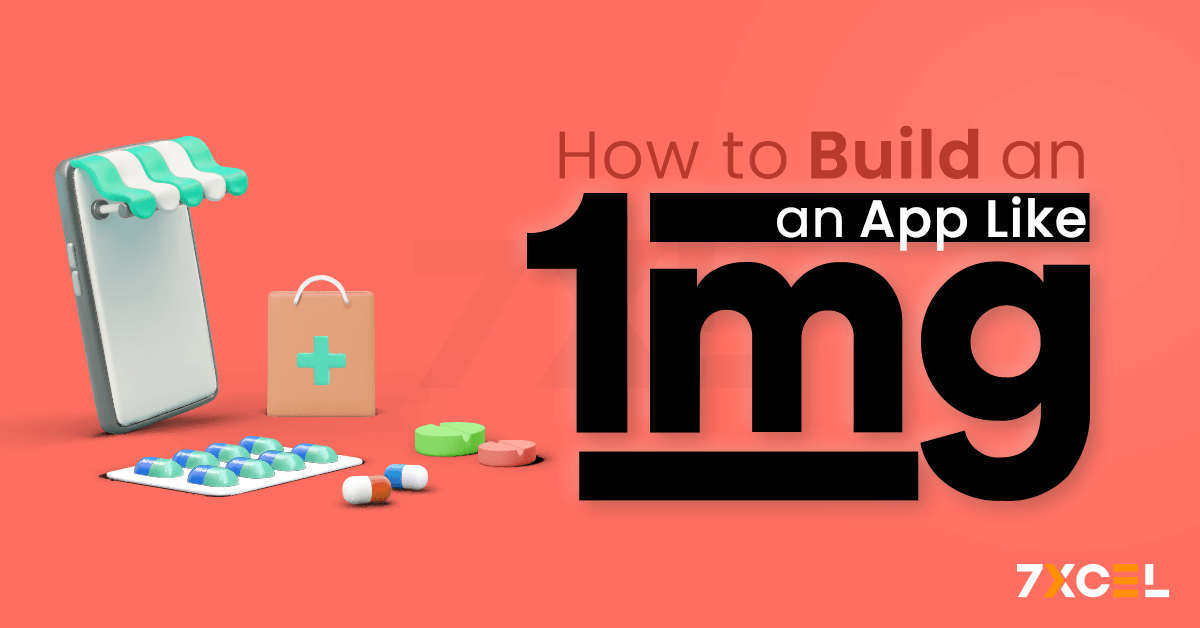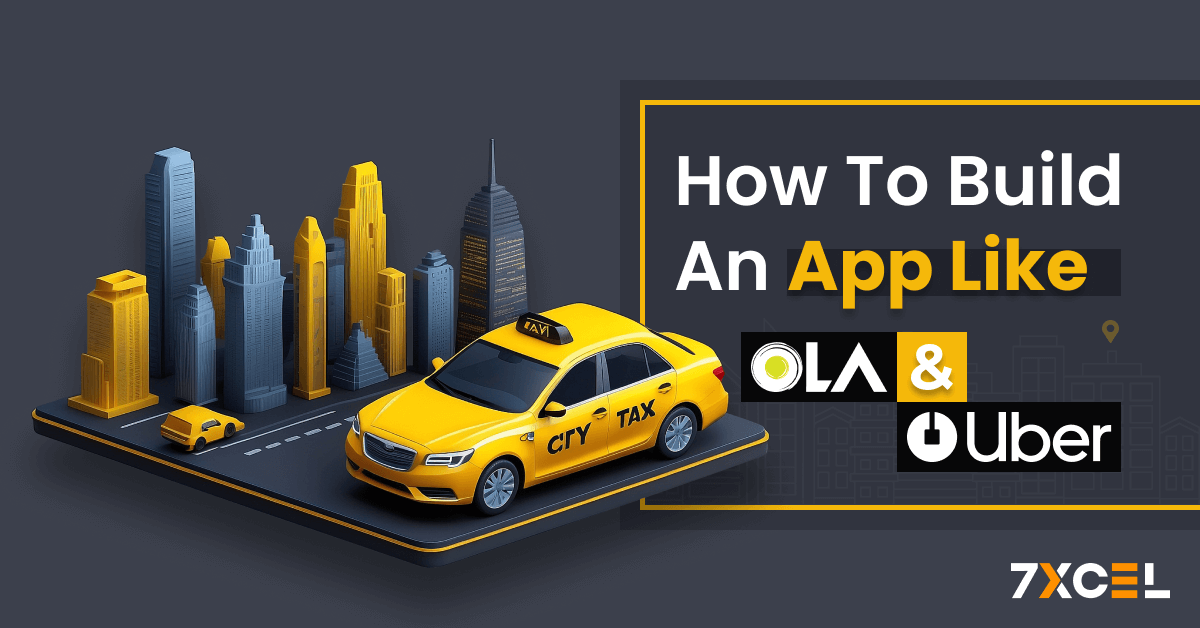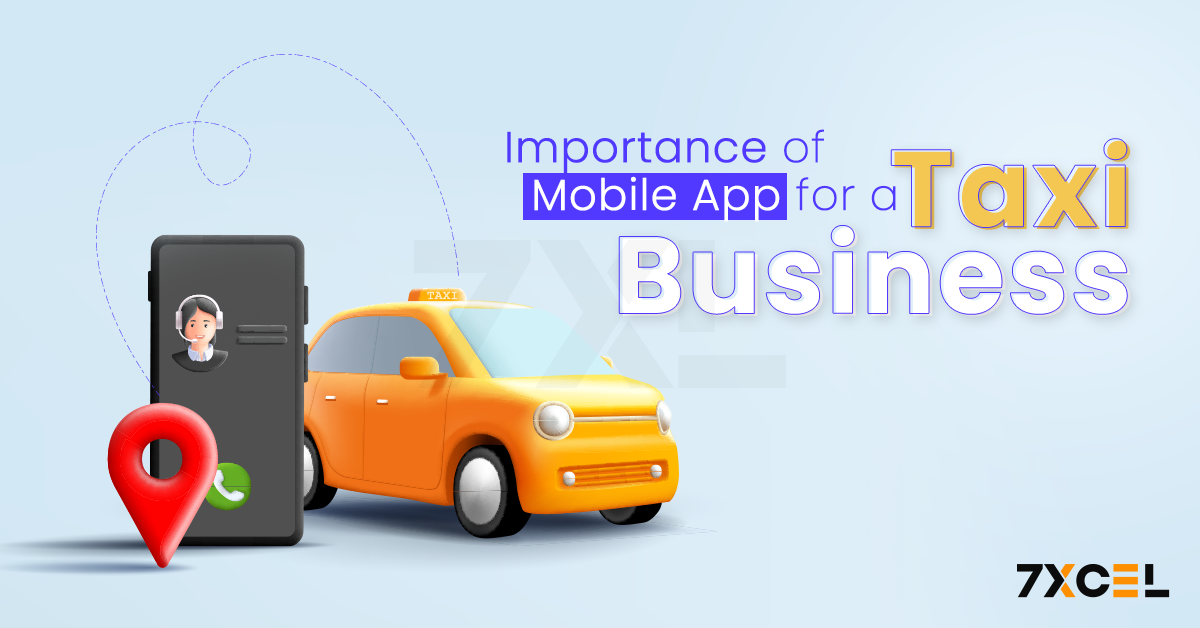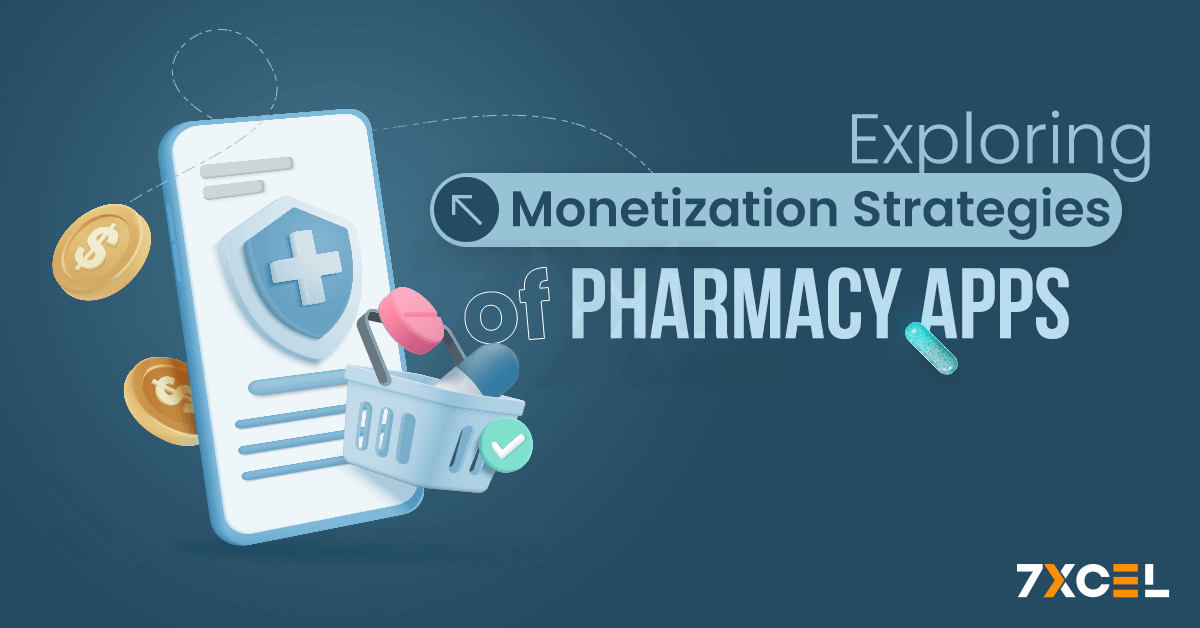Quick Summary:
Building an app like 1mg involves understanding the online healthcare market, defining the business model, identifying key and advanced features, and following a structured development process. The key components of this handbook will be examined in developing a successful online pharmacy app, including current market stats, business models, app features, development steps, cost estimation, monetization strategies, and why 7xcel is the ideal partner for your app development needs.
The digital transformation in healthcare has made accessing medical services easier than ever. Apps like 1mg provide users with the convenience of ordering medicines, booking lab tests, and consulting doctors online. If you aim to create a similar app, partnering with an experienced IT company can ensure your project’s success.
Market Stats for Building an Online Medicine Delivery App
The market for healthcare apps has expanded significantly in recent years due to factors such as the growing use of smartphones, increased internet usage, and the growing need for digital health solutions. Here are some key market statistics and trends that highlight the potential of developing a medicine app like 1mg:
Global Healthcare App Market
- Market Size: Estimates for the size of the mHealth apps market place it at USD 56.26 billion in 2022 and show a CAGR of 40.2% from 2022 to 2030, when it is expected to reach USD 861.40 billion from USD 80.87 billion in 2023.
- Adoption Rate: The size of the worldwide telemedicine market was estimated at $41.63 billion in 2019 and is projected to grow at a 15.1% compound annual growth rate (CAGR) to $155.1 billion by 2027.
- User Preferences: According to a survey, 74% of patients in the U.S. are comfortable using telemedicine services, and 76% prioritize access to telemedicine over inperson visits.
- Investment Trends: Investment in digital health startups reached a record $14.6 billion in the first half of 2021, reflecting the increasing investor interest in innovative health solutions.
Key Features of the App like 1mg
Creating an app similar to 1mg (an online pharmacy and healthcare platform) involves integrating several key features to ensure it provides a comprehensive, userfriendly, and secure experience for users. Here are some essential features to consider:

1. User Registration and Profiles
- User Accounts: Allow users to create accounts using email, phone numbers, or social media accounts.
- Profile Management:Users have the ability to control the details of their prescriptions, medical history, and personal information.
2. Search and Navigation
- Product Search: Advanced search functionality to find medicines, health products, and lab tests.
- Categories: Organized categories for easy browsing (e.g., medicines, health products, diagnostics, etc.).
- Filters and Sorting: Options to filter products by brand, price, discount, and sorting by relevance or popularity.
3. Medicine and Product Information
- Detailed Descriptions: Comprehensive information about medicines, including uses, dosage, side effects, interactions, and precautions.
- Product Images: Clear images of products for better recognition.
- Reviews and Ratings: User reviews & ratings for products to help others make informed decisions.
4. Prescription Management
- Upload Prescriptions: Option to upload prescriptions directly through the app.
- Prescription Verification: A process for verifying uploaded prescriptions by certified pharmacists.
- Refill Reminders: Notifications for prescription refills.
5. Online Consultation
- Doctor Consultations: Book appointments for online consultations with healthcare professionals.
- Chat/Video Call: Options for consulting with doctors via chat or video call.
- Medical Advice: Access to medical advice and recommendations based on symptoms.
6. Diagnostics and Lab Tests
- Book Lab Tests: Facility to book diagnostic tests and health checkups.
- Home Sample Collection: Option for home sample collection services.
- Test Results: Access to test results within the app.
7. Order Management
- Easy Ordering: Simple and secure process for placing orders.
- Order Tracking: Realtime tracking of order status and delivery updates.
- Order History: Access to past orders and repeat order functionality.
8. Payment Integration
- Multiple Payment Options: Integration with multiple payment mechanisms, including net banking, wallets, credit/debit cards, UPI, and others.
- Secure Transactions: Ensuring secure and encrypted payment transactions.
- Cash on Delivery: Option for cash on delivery.
9. Offers and Discounts
- Promotional Offers: Display ongoing discounts, offers, and coupon codes.
- Loyalty Programs: Implement loyalty points or rewards for frequent users.
10. Notifications and Alerts
- Push Notifications: Alerts for order status, offers, refill reminders, and health tips.
- SMS/Email Notifications: Alternative communication channels for updates.
11. Customer Support
- Help and Support: Inapp support for resolving queries and issues.
- FAQs: Comprehensive FAQ section to assist users with common questions.
12. Health and Wellness Content
- Articles and Blogs: Health tips, wellness articles, and medical news.
- Videos and Tutorials: Educational videos on healthrelated topics.
13. Regulatory Compliance
- Data Privacy: Ensuring user data privacy and compliance with local regulations (e.g., HIPAA, GDPR).
- Authentication: Secure login and authentication mechanisms.
14. Admin Panel
- Inventory Management: Tools for managing stock levels and product information.
- Order Management: Admin controls for tracking and managing orders.
- User Management: Managing user accounts and access levels.
- Analytics and Reporting: Insights into sales, user activity, and other metrics.
15. Mobile Responsiveness
- Responsive Design: Make sure the application is prepared for both Android and iOS devices.
- Offline Access: Limited functionality for offline access and usage.
Incorporating these features can help create a robust and userfriendly healthcare app similar to 1mg, offering a seamless experience for users seeking medical products and services.
How to Build an App Like 1mg?
Building an app like 1mg involves several key steps, from planning and research to development, testing, and launch. Here’s a comprehensive guide to help you through the process:
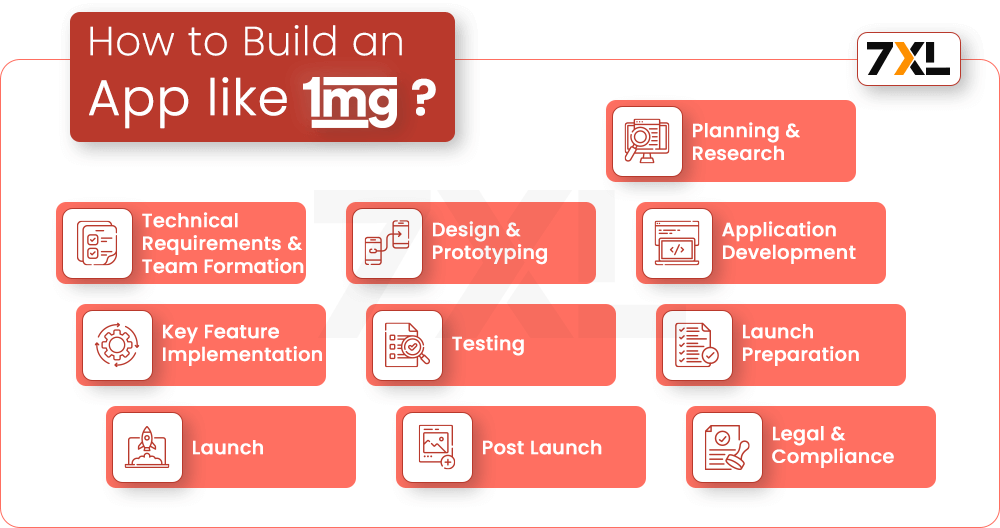
1. Planning and Research
- Market Research: Analyze the market, understand your competitors, and identify your target audience.
- Define Goals and Objectives: Clearly outline what you want to achieve with your app.
- Feature List: Create a detailed list of features you want to include in your app based on your research and goals.
2. Technical Requirements and Team Formation
- Technology Stack: Select a frontend (React Native, Flutter) & backend (Node.js, Django) technology stack that makes sense for your needs.
- Form Your Team: Assemble a team of developers, designers, testers, and project managers. If inhouse resources are limited, consider outsourcing.
3. Design and Prototyping
- Wireframes: Create wireframes to visualize the app’s layout and structure.
- UI/UX Design: Develop the user interface & user experience, focusing on ease of use, accessibility, and visual appeal.
- Prototype: Develop a clickable prototype to demonstrate the app’s workflow and get feedback.
4. Development
- FrontEnd Development: With the designs as a guide, create the user interface. Make certain the application functions effectively across a range of devices and is responsive.
- BackEnd Development: Set up the server, database, and APIs to handle data processing, storage, and retrieval. Ensure scalability and security.
- Integration: Integrate third-party services like payment gateways, SMS, email services, etc.
5. Key Feature Implementation
- User Authentication: Implement secure user registration and login functionalities.
- Product Search and Navigation: Develop robust search and navigation features for easy browsing.
- Prescription Management: Enable users to upload, manage, and verify prescriptions.
- Online Consultation: Integrate chat or video call functionalities for doctor consultations.
- Diagnostics and Lab Tests: Implement features to book tests, manage appointments, and display results.
- Order Management: Develop features for placing orders, tracking, and history.
- Payment Integration: Integrate multiple secure payment options.
- Notifications: Implement push notifications, SMS, and email alerts.
6. Testing
- Unit Testing: Test individual components for functionality.
- Integration Testing: Ensure that different components of the app work together seamlessly.
- User Acceptance Testing (UAT): Seek input from real consumers to pinpoint problems and areas in need of development.
- Performance Testing: Test the app for load handling, speed, and overall performance.
- Security Testing: Make certain no vulnerabilities or possible dangers exist in the app.
7. Launch Preparation
- Beta Launch: Release a beta version to a limited audience to gather feedback and identify bugs.
- Marketing Plan: Create a marketing strategy to promote your app through social media, influencers, SEO, and other channels.
- App Store Optimization (ASO): Optimize your app’s listing on the Apple App Store & Google Play Store to improve visibility and downloads.
8. Launch
- Final Deployment: Deploy the app on the App Store and Google Play Store.
- Marketing Campaign: Kick off your marketing campaign to attract users.
- Monitor Performance: Continuously monitor the app’s performance, user feedback, and reviews.
9. Post Launch
- Regular Updates: Continuously update the app with new features, improvements, and bug fixes.
- Customer Support: Provide excellent customer support to handle user queries and issues.
- Analytics and Feedback: To help you decide what should be updated in the future, employ analytics tools to monitor user behavior and collect feedback.
10. Legal and Compliance
- Data Privacy: Make sure that data privacy laws such as HIPAA, GDPR, and others are followed.
- Terms and Conditions:All legal documentation, including the privacy policy and terms and conditions, should be clearly outlined.
A meticulous approach to planning, carrying out, and maintaining continual improvement is needed when developing an cost efficient app like practo or 1mg. These guidelines might help you develop a successful healthcare app that appeals to your target market while concentrating on providing an excellent user experience.
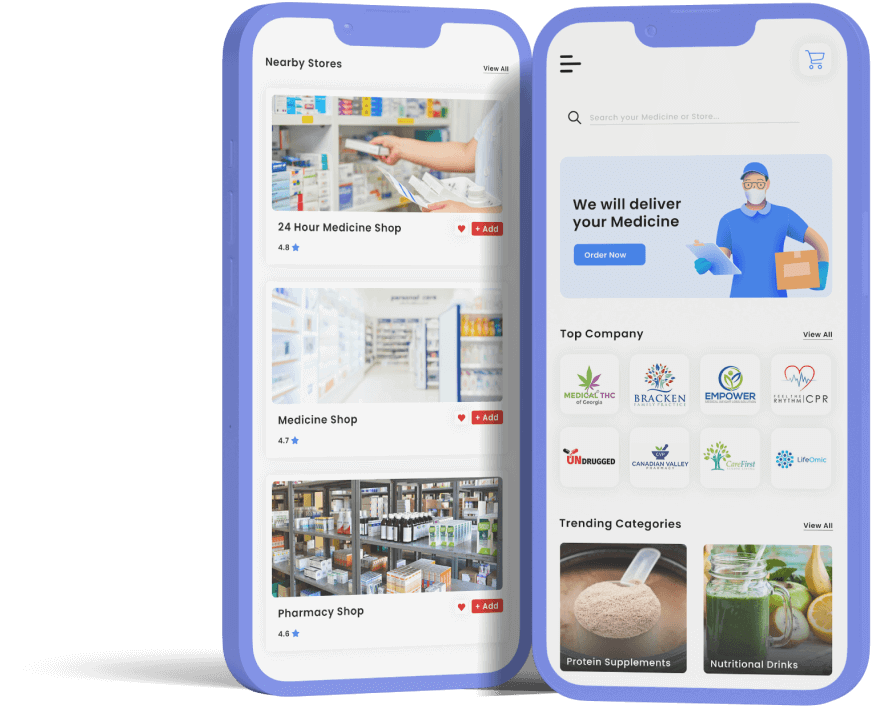
Ready to prescribe convenience right to your customers’ doors?
Boost your medicine delivery business with 7xcel’s cutting-edge app development, & Empower patients with the tap of a button – your pharmacy, their pocket.
Technologies and Tools Required For App Like 1mg
Creating a comprehensive app like 1mg requires choosing the right technologies and tools to ensure scalability, security, and a seamless user experience. Here’s an elaborated guide on the technologies and tools you will need for different aspects of the app development:
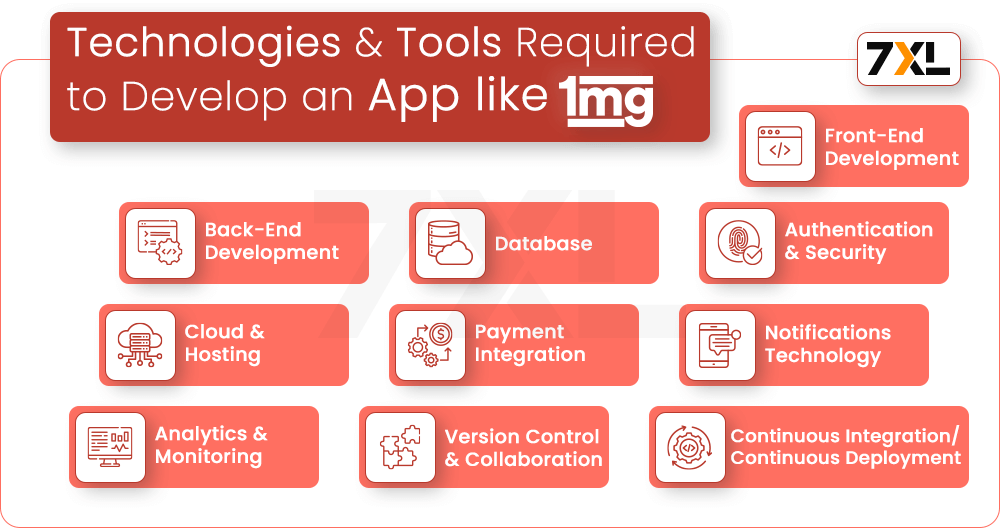
1. Front-End Development
Technologies:
- React Native: For creating cross-platform mobile applications with a single codebase that function on both iOS and Android.
- Flutter: An alternative for cross-platform development, known for its fast performance and expressive UI.
Tools:
- Expo: For building, deploying, and testing React Native apps.
- Android Studio: For Android development and testing.
- Xcode: For iOS development and testing.
- Figma or Adobe XD: For UI/UX design and prototyping.
2. Back-End Development
Technologies:
- Node.js: For building a scalable server-side application with JavaScript.
- Django: A high-level Python framework that encourages rapid development and clean, pragmatic design.
- Express.js: A minimal and flexible Node.js web application framework for building APIs.
- Spring Boot: For Java-based backend development, providing a robust and scalable solution.
Tools:
- Postman: For testing APIs.
- GraphQL: For more efficient data fetching compared to REST APIs.
- Docker: For containerizing applications to ensure consistency across development and production environments.
3. Database
Technologies:
- MongoDB: A NoSQL database for flexible, JSON-like storage.
- PostgreSQL: An open-source relational database with powerful features.
- MySQL: Another popular relational database for structured data.
Tools:
- Mongoose: An ODM for MongoDB and Node.js.
- Sequelize: A promise-based Node.js ORM for SQL databases.
- pgAdmin: A management tool for PostgreSQL.
4. Authentication and Security
Technologies:
- OAuth 2.0: For secure user authentication.
- JWT (JSON Web Tokens): For secure token-based authentication.
- SSL/TLS: For securing data transmission.
Tools:
- Auth0: A flexible and drop-in solution to add authentication and authorization services to your applications.
- Firebase Authentication: For a simpler authentication solution with pre-built UI libraries.
5. Cloud and Hosting
Technologies:
- AWS (Amazon Web Services): For scalable cloud infrastructure.
- Google Cloud Platform: An alternative for cloud services.
- Microsoft Azure: Another robust cloud service provider.
Tools:
- EC2: For virtual servers in the cloud.
- S3: For scalable object storage.
- CloudFront: For content delivery network (CDN) services.
- Firebase: For real-time databases and backend services.
6. Payment Integration
Technologies:
- Stripe: For processing online payments.
- PayPal: Another popular payment gateway.
- Razorpay: Common in India for processing payments.
Tools:
- Braintree: A full-stack payment platform to accept, process, and split payments.
- Square: For payment processing with easy integration.
7. Notifications
Technologies:
- Firebase Cloud Messaging (FCM): For push notifications.
- Twilio: For SMS notifications.
Tools:
- OneSignal: A powerful and reliable push notification service.
- Pushwoosh: For push notification and in-app messaging services.
8. Analytics and Monitoring
Technologies:
- Google Analytics: For tracking & reporting website traffic.
- Firebase Analytics: For tracking user behavior in mobile apps.
Tools:
- Sentry: For error tracking and monitoring.
- Mixpanel: For advanced user analytics and event tracking.
- New Relic: For application performance monitoring.
9. Version Control and Collaboration
Technologies:
- Git: For version control.
Tools:
- GitHub: A web-based platform for version control & collaboration.
- GitLab: An alternative to GitHub with integrated CI/CD.
- Bitbucket: Another alternative with robust features for teams.
10. CI/CD (Continuous Integration/Continuous Deployment)
Technologies:
- Jenkins: An open-source automation server for building, deploying, and automating projects.
- CircleCI: For continuous integration and delivery.
- Travis CI: Another CI/CD service for building and testing software projects.
Tools:
- Docker: For containerization.
- Kubernetes: For container orchestration.
- Ansible: For automation of configuration management, application deployment, and task automation.
To successfully develop an app like 1mg, choosing the appropriate technology and tools is crucial. The technology stack must be stable, scalable, and secure to handle the intricate needs of a healthcare platform and online pharmacy.
Collaborating with a specialized Medicine Delivery App Development Company can help in selecting and implementing the right technologies to meet these requirements. Their expertise ensures a seamless development process, resulting in a robust platform that delivers a superior experience to users. By leveraging their knowledge, it is possible to create a reliable and efficient app that stands out in the competitive healthcare market.
Challenges in Developing an App Like 1mg
Creating a healthcare app like 1mg involves navigating a variety of complex challenges. Addressing these effectively is crucial to developing a robust, secure, and user-friendly application. Here are the primary challenges you may face:
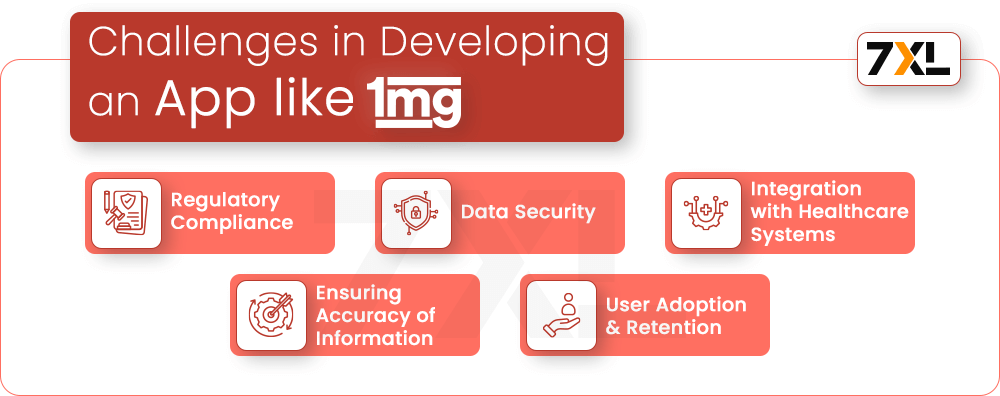
Regulatory Compliance
Challenge: To protect the security and privacy of user data, healthcare apps have to abide by strict laws. The General Data Protection Regulation (GDPR) is applicable in Europe, whereas HIPAA (Health Insurance Portability and Accountability Act) standards are applicable in the US. Penalties from the law and harm to your app’s reputation may arise from noncompliance.
Solution:
- Conduct thorough research on relevant healthcare regulations.
- Implement robust data protection measures, such as end-to-end encryption and secure authentication.
- To make sure your app complies with all regulations, speak with legal professionals.
- Regularly update your app to stay compliant with evolving regulations.
Data Security
Challenge: Protecting sensitive health information from breaches and cyber-attacks is paramount. Healthcare apps are prime targets for cybercriminals due to the valuable data they handle.
Solution:
- Use advanced encryption methods for data storage and transmission.
- Implement multi-factor authentication to enhance security.
- Identify and mitigate possible risks by conducting frequent security audits and vulnerability assessments.
- Educate the consumers on how to protect their data.
Integration with Healthcare Systems
Challenge: It can be difficult to integrate your app seamlessly with current healthcare systems, such as laboratory management systems and Electronic Health Records (EHR). This integration is essential for providing a cohesive user experience and ensuring smooth data flow.
Solution:
- Utilize standardized APIs to facilitate integration with various healthcare systems.
- Partner with experienced healthcare IT vendors to streamline the integration process.
- Conduct thorough testing to ensure seamless data exchange between systems.
- Provide training for healthcare providers on using the integrated systems effectively.
Ensuring Accuracy of Information
Challenge: Providing accurate and up-to-date information about medicines, health conditions, and treatments is critical. Inaccurate information can lead to misuse of the app and harm user trust.
Solution:
- Collaborate with medical professionals and experts to verify the accuracy of the information provided in the app.
- Implement a content management system to facilitate regular updates.
- Source health information and drug databases from trusted and reputable sources.
- Allow users to report inaccuracies and provide feedback to ensure continuous improvement.
User Adoption and Retention
Challenge: Attracting users to your app and keeping them engaged over time can be difficult.Consumer expectations for usability and functionality are high, and competition is severe.
Solution:
- Conduct user research to understand the requirements & preferences of your target audience.
- Design an intuitive & user-friendly interface that enhances the user experience.
- Offer personalized features and recommendations based on user data.
- Provide prompt & effective customer support to address user issues.
- Implement marketing strategies to attract new users and retain existing ones, such as loyalty programs, rewards, and regular updates with new features.
Addressing these challenges head-on can set the foundation for a successful healthcare app like 1mg. By prioritizing regulatory compliance, data security, seamless integration, accurate information, and user engagement, you can develop a trusted and widely-used healthcare platform.
Conclusion
Creating an app like 1mg involves tackling challenges like regulatory compliance, data security, and system integration. With thorough planning and the right technologies, you can build a user-friendly healthcare app that stands out. Ready to transform healthcare? Our expert team will guide you every step of the way. Contact with us today to get started.
